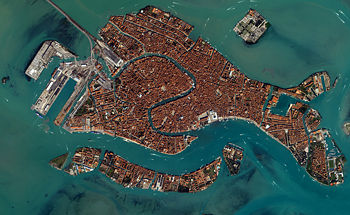Venice: Difference between revisions
imported>Kjetil Ree (→Bibliography: moving to subpage) |
imported>Kjetil Ree (+image) |
||
| Line 1: | Line 1: | ||
{{subpages}} | {{subpages}} | ||
[[Image:Venice from space.jpg|right|thumb|350px|{{#ifexist:Template:Venice from space.jpg/credit|{{Venice from space.jpg/credit}}<br/>|}}Venice is built on 118 tiny islands linked by canals and bridges.]] | |||
'''Venice''' (Italian: '''Venezia''') is a city and major seaport in [[Veneto]] in Nothern [[Italy]]. It is famous for its canals, and for its role as a republic and a major trade hub in medieval Europe. | '''Venice''' (Italian: '''Venezia''') is a city and major seaport in [[Veneto]] in Nothern [[Italy]]. It is famous for its canals, and for its role as a republic and a major trade hub in medieval Europe. | ||
Revision as of 17:49, 2 April 2008
Venice (Italian: Venezia) is a city and major seaport in Veneto in Nothern Italy. It is famous for its canals, and for its role as a republic and a major trade hub in medieval Europe.
History
The history of Venice begins with the Langobard invasion in the sixth century, where numerous Italians were driven onto the islands of the Adriatic. Venice got its first doge, Orso, in 727, and got its de facto independence from the Byzantine Empire in the early ninth century. After a period of turbulence, Venice transformed into a republic between 1140 and 1160.
After the sacking of Constantinople in 1204, the Venetians filled the power vacuum by creating their own commercial empire in the eastern Mediterranean. The Venetian empire included many Greek islands, such as Crete and later Cyprus. Venetian control over Crete ended when the Ottomans conquered it in 1645–69.
The republic was ended by Napoleon in 1797, and the Austrians took control over the city and its possessions. Venice joined the unified Italian kingdom in 1966, after Austria's defeat to Prussia.
